It's been three weeks since we last played Dwimmermount, and with a brief recap of events the players were ready to confront the enemies they heard in the caves swiftly approaching their position.
The party came face to face with
Guran, the mad dwarf who had been creating the kobolds. Though they never discovered this as their conversation quickly became combative and antagonistic. When they refused to leave Dwimmermount, or even acknowledge that it belonged to him and his "dwarves," he went berserk and attacked. He was quickly defeated, and his fleeing kobolds were easily hunted down and slaughtered.
They debated over a place where they could rest for an hour or so and mentioned the hidden chapel in the eastern part of the level, but quickly stopped talking about it since they didn't want to reveal the location to Appius. They ventured back to the "timeless room" and discovered three orcs camping. They killed two of the orcs before they could react, but the last one surrendered by offering to show a map to his leader's throne room.
For initiative during combat, I've been having the players roll 1d10 and add their Dexterity bonus. I feel like this gives a better timeline to the round and makes the Dexterity bonus more important than the d20 skill check that the 5e rules call for.
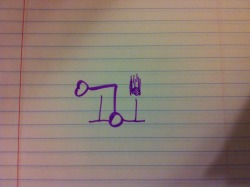
He led them to the circular mosaic room and showed a crude map drawn into the lines of the mosaic, explaining that the circular room here led to another circular room down below and the elaborate graffiti marked Segur's "throne" room.
Sulla, unsatisfied with the map, slit the orc's throat.
They rested in the "timeless room" then explored the magically locked doors to the last circular room off of the main "Mavors corridor" with the key disc they had recovered from the Spawn of Arach-Nacha. Inside they found a chamber that responded to the key disc and Sulla sent his familiar to scout the vertical shaft within.
Three things:
1) I allowed Sulla's familiar to search the entire shaft. 5e rules limit some of the usefulness of the familiar beyond 100 feet, but I decided to allow telepathic communication throughout the entire shaft. Additionally, I don't like the way 5e uses familiars as there seems to be no drawback to using them carelessly.
2) The book doesn't state where exactly the elevator is, so I parked it at the upper level effectively blocking the door to the Divinitarium. Meaning the players will either be forced to turn on the elevator's power or destroy the elevator before they can ever explore this level.
3) We recently discovered that any character can Identify a magic item during a short rest (DMG p. 136)
and Ilona used this ability on Guran's warhammer, which she had looted. Rather than make it a +1 weapon, I gave it better damage and a magical +1 to offhand attacks if the warhammer is used one-handed (even though it is also a versatile weapon).
The party decided to explore the rest of the caves (
they had two rooms left to discover) and found Guran's treasure chests as well as two more giant spiders, which they made quick work of. Using
my previously detailed method for generating treasure, they found roughly 1600 copper pieces. They also found the shrine to Tyche, where Horatius placed a gold coin amongst the small hoard already in her outstretched hands.
They discovered the Hall of Memories, where I implied that the pillars could potentially be removed from the floor, transported elsewhere, and sold for a vast sum. The scholar amongst them, Sulla, watched the memories and discerned that there were some things revealed in the images that did not match the history he had been taught.
They continued downward to the Reliquary...
at the bottom of the stairs the party was attacked by more of the silvery-black skeletons they had seen in the chapel on the first level, but they made short work of the magical constructs.
Sulla and Ilona wanted to find the other stairwell that led back up to the first level and so they ventured west and came to two doors, one north and one south. They chose to go north and found a storeroom with smashed crates and rotted goods, along with five burlap sacks with man-sized shapes groaning and struggling to get out. They opened one of the sacks to find a dessicated but animated corpse fighting to free itself. They bashed its head in and then spent a few minutes stabbing and bludgeoning the other four sacks.
I'm not sure why this room has five zombies trussed up inside burlap sacks, maybe its detailed somewhere and I forgot, or maybe this is just one of those weirdly random rooms, but it was at this point that I made a little note that one of those sacks did not have a zombie inside of it. This death will come back to haunt them. (maybe even literally)
Continuing to the north, they passed through several rooms. One with four pillars representing the elements surrounding a tiled mosaic of Telluria, and another with pillars made of rare metals. They discussed ways of removing the rare metal pillars but eventually decided to continue onward and return to this room later. They approached the door at the end of this hall, realizing they had traveled quite a distance north, and Sulla could hear voices beyond the door. They were arguing about their leader's decisions and
Sulla's Passive Perception is 20 and he is the only character who can speak Bestial.
They burst into the room and found damaged glass tubes stretched out in rows across the room. On the other side of one of these rows they could see four creatures unlike anything they had seen before. Roughly humanoid forms with thick bulging arms and squat legs, the length of their faces ridged with short black horns protruding where their noses and foreheads should be. They charged in and killed all four of the creatures with little hesitation.
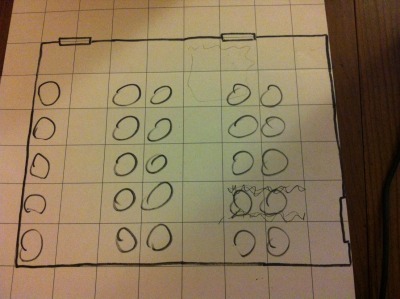 This room is called Stasis Chamber #2. It is described as being identical to Stasis Chamber #1. Stasis Chamber #1 is described as "filled with two dozen vitreum tubes that stand slightly taller than a human being. The tubes are found in four rows of six..." except the shape of both of these rooms doesn't match how that configuration of rows is described. Frustratedly, I just filled in rows of "tubes" on my map and told the players that it would require an action to move through the tubes - due to smashing and forcing their way through reinforced glass (vitreum) - and that each square of vitreum tubes counted as difficult terrain.
This room is called Stasis Chamber #2. It is described as being identical to Stasis Chamber #1. Stasis Chamber #1 is described as "filled with two dozen vitreum tubes that stand slightly taller than a human being. The tubes are found in four rows of six..." except the shape of both of these rooms doesn't match how that configuration of rows is described. Frustratedly, I just filled in rows of "tubes" on my map and told the players that it would require an action to move through the tubes - due to smashing and forcing their way through reinforced glass (vitreum) - and that each square of vitreum tubes counted as difficult terrain.
You can see in this picture where Ilona smashed through some of the tubes and later Sulla placed a Grease
spell on the floor to prevent the hobgoblins from escaping.
 This room, and this entire level, is described as having hobgoblins living here, but I should point out that I've been deliberately describing the orcs to my players as "pig-faced" and using 1st edition AD&D images of orcs to hammer this point home. I decided pretty early on that I wanted every unusual race within Dwimmermount to have some kind of animalistic feature, to imply that when these races were magically created by the Ancients that they were made using existing species.
This room, and this entire level, is described as having hobgoblins living here, but I should point out that I've been deliberately describing the orcs to my players as "pig-faced" and using 1st edition AD&D images of orcs to hammer this point home. I decided pretty early on that I wanted every unusual race within Dwimmermount to have some kind of animalistic feature, to imply that when these races were magically created by the Ancients that they were made using existing species.
I'm using the 5e stats for hobgoblins, but I've searched up these images to show what the "hobgoblins" look like.
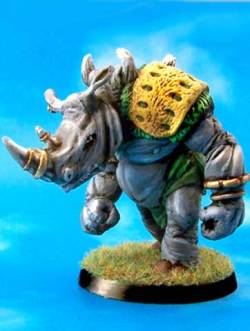
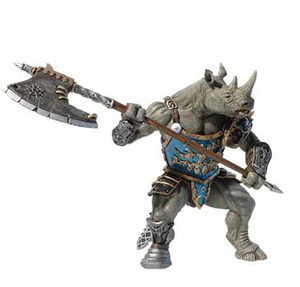
They explored the southeastern door because one of the hobgoblins had tried to escape through this door. Inside were shelves and cabinets filled with vials and jars, some still held powders and liquids. Sulla cast Detect Magic and took anything that radiated with magic, they abandoned the rest and moved on.
I don't like using nonmagical means for creating potions and since this room has some weird alchemical objects sitting around, I decided on the fly that Sulla's spell would detect anything that was already made and ready to use. I rolled a d10 and got a 7, that's how many potions he found. If the party had an alchemist with them then perhaps I could have played this room out a bit more, but the players were also keen to track down where the hobgoblin wanted to retreat to and a few potions weren't going to slow them down.
They began to turn south in the next room, another chamber filled with vitreum tubes, and immediately saw light at the end of one of the corridors. The party began using ranged attacks as soon as they saw more of the hobgoblins and a brief fight ensued. Two of the hobgoblins tried to escape, but were cut down before they could get very far. Loud noises still echoed down the halls and the party could hear footsteps approaching from beyond the circular room.
At the end of that last round of combat the minis looked like this
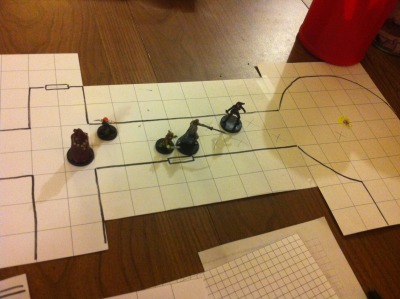
their map currently looks like this
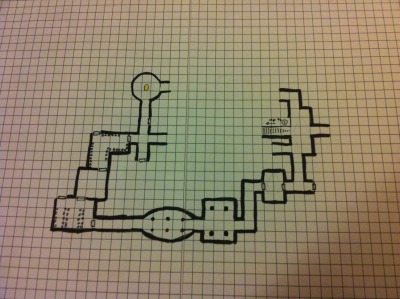
and according to my timekeeping they've been awake for a little over 13 hours...
 He led them to the circular mosaic room and showed a crude map drawn into the lines of the mosaic, explaining that the circular room here led to another circular room down below and the elaborate graffiti marked Segur's "throne" room.
He led them to the circular mosaic room and showed a crude map drawn into the lines of the mosaic, explaining that the circular room here led to another circular room down below and the elaborate graffiti marked Segur's "throne" room.  This room is called Stasis Chamber #2. It is described as being identical to Stasis Chamber #1. Stasis Chamber #1 is described as "filled with two dozen vitreum tubes that stand slightly taller than a human being. The tubes are found in four rows of six..." except the shape of both of these rooms doesn't match how that configuration of rows is described. Frustratedly, I just filled in rows of "tubes" on my map and told the players that it would require an action to move through the tubes - due to smashing and forcing their way through reinforced glass (vitreum) - and that each square of vitreum tubes counted as difficult terrain.
This room is called Stasis Chamber #2. It is described as being identical to Stasis Chamber #1. Stasis Chamber #1 is described as "filled with two dozen vitreum tubes that stand slightly taller than a human being. The tubes are found in four rows of six..." except the shape of both of these rooms doesn't match how that configuration of rows is described. Frustratedly, I just filled in rows of "tubes" on my map and told the players that it would require an action to move through the tubes - due to smashing and forcing their way through reinforced glass (vitreum) - and that each square of vitreum tubes counted as difficult terrain.  This room, and this entire level, is described as having hobgoblins living here, but I should point out that I've been deliberately describing the orcs to my players as "pig-faced" and using 1st edition AD&D images of orcs to hammer this point home. I decided pretty early on that I wanted every unusual race within Dwimmermount to have some kind of animalistic feature, to imply that when these races were magically created by the Ancients that they were made using existing species.
This room, and this entire level, is described as having hobgoblins living here, but I should point out that I've been deliberately describing the orcs to my players as "pig-faced" and using 1st edition AD&D images of orcs to hammer this point home. I decided pretty early on that I wanted every unusual race within Dwimmermount to have some kind of animalistic feature, to imply that when these races were magically created by the Ancients that they were made using existing species. 


